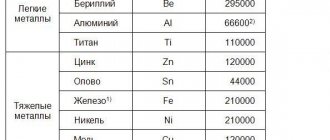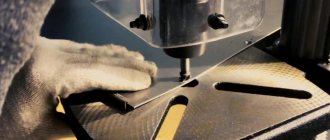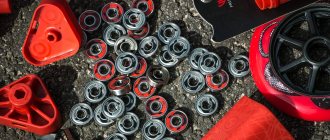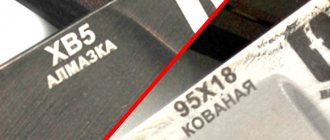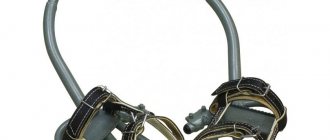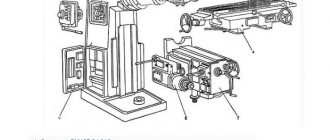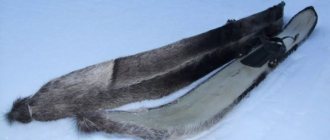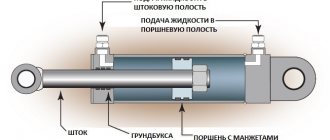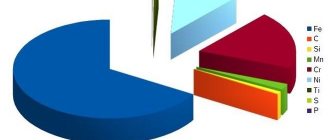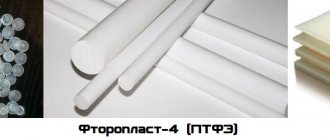Definition of screw
Translated, the term means “thread”. The hardware consists of several structural elements - a rounded leg and a cap on the tip. The leg fixes the parts, and with the help of the head the hardware is mounted. The key difference between screws and bolts is the shape of the head, which entails different fastening methods. So, the screw has a small size, and the bolt has a hexagon-shaped head.
The screw head has several modifications in its head appearance:
- cylindrical shape of screws. You can fix such a screw using a hex key;
- hemisphere. Mounted using different screwdrivers depending on the cross-section;
- truncated cone at the screws. Convenient for “secret” installation. To do this you will need a hexagon or screwdrivers;
- hex head screws. Only found on large size products. In this case, it is difficult to compare with a bolt based on the type of head. They are distinguished only by the size and shape of the caps.
Basic concepts and types of fasteners
Fasteners are classified according to design features, type of connection and area of application. Main types of fasteners:
- Nails are a rod with a sharp end. The nail head may be slotted or smooth, depending on the type of product. Nails are widely used and have an important advantage: high pullout resistance with simple installation and low cost.
- Dowels - designed to hold another fastening element (screw, bolt) inside the hole. Dowels come in metal and plastic. Inside the hole, they open up and rest against the walls, which ensures strong fixation.
- An anchor is a complex fastening element consisting of several parts. Depending on the design, there are frame, driven, wedge-shaped anchors, products with rings and half rings.
- Self-tapping screws are a screw with a sharp end and thread. The main feature of a self-tapping screw is the ability to cut threads inside the material when screwed into the base.
- Screws are fasteners with a conical shaft and a head in which there is a slotted hole for a screwdriver.
- Studs are rods with external threads. Used complete with nuts and washers. The thread is cut equally along the entire length of the rod, or varies in different areas of the product.
- Washers - act as a lining in the fastening joint, placed between the screw head and the nut.
Hardware is distinguished by strength classes (there are 11 classes) and by size. Another important feature of the classification of hardware is the type of head:
- With rope eyelet, foldable.
- Anchor type - for fastening inside concrete products.
- Rigging eye bolts with a ring in the head.
- Hexagonal head shape.
- Conical head for hidden connection.
- Semicircular head - has a slot for using a screwdriver when tightening fasteners.
- Cylindrical head for using a hex screwdriver.
Definition of a bolt according to GOST
The bolt, according to information from GOST standards, is used to install and strengthen massive structures, bridges, and powerful structures. For proper use of bolts, it is important to calculate not only the loads to be withstood, but also the features of the mating structure. In addition to the maximum permissible weight, shear and compression loads, impacts, and resistance to external factors are taken into account.
According to GOST definition, by bolt we mean a metal fastener with a head and an external thread located at different ends of the product. It is fixed with a nut or threaded hole. When installed correctly, it ensures a reliable connection without the risk of shifting and deformation of the structure.
Competitor comparison
To understand what is better, what hardware should be used in a particular situation, you need to understand all the differences, advantages and disadvantages. It is also recommended to take into account the dimensions of parts and the frequency of disassembly/assembly of structures.
Key Features
A bolt is a universal fastener in the form of a rod with an external thread, fundamentally different from its competitor in the faceted head.
A stud is a cylindrical rod that has external threads at both ends or along its entire length. It is used where it is impossible to use a bolted connection - the parts are too wide, there is no room for the bolt head, or where it is necessary to obtain a compact connection. A pin is also used if it is necessary to connect parts so that there is space between them.
Advantages
Each type of fastener has advantages and preferred applications.
The advantages of a bolted connection are as follows:
- Detachable, multiple assembly/disassembly possible.
- Simplicity, precision in manufacturing, a wide variety of hardware - from general purpose to specialized.
- Small forces when connecting a bolt with a nut provide a strong tightening of the elements, which can be compared with welding in terms of reliability and service life.
- A bolted connection is used when the thickness of the parts being connected is relatively small, or when the material of the part is not strong enough for threading.
- With a wide variety of parts arrangement options, assembly is not difficult.
Low cost combined with effective and reliable fastening makes the bolt a popular fastening option.
One of the main advantages of a bolted connection is that there is no need for threads on the parts being connected.
Advantages of stud connections:
- This fastener is indispensable where the body of the parts is large and it is impossible to make a through hole for the bolt.
- The element is in demand if there are weight restrictions for the entire structure.
- Suitable for use if frequent assembly/disassembly of the structure is required.
- It is used instead of screws when the material strength of the entire threaded part is insufficient. An example is aluminum alloys.
- Easily installed in hard to reach places.
The tension when tightening fasteners is distributed more evenly compared to bolted fasteners.
Flaws
In addition to the advantages, you need to consider the disadvantages of fasteners.
Bolts have the following disadvantages:
- Usually it is necessary to use several pieces at once, which significantly makes the structure heavier.
- When tightening, increased stress occurs at the junction of the head and the rod.
- Since fastening requires an ideal tandem of a bolt and a nut, and it is also possible to use a third element - a washer, the correct choice of hardware is required. If fasteners are selected incorrectly, joining and fastening parts becomes impossible. But if the fixation of parts is successful, then non-ideal dimensions lead to early failure of the entire structure.
Disadvantages of studs:
- can bend, which means they lose strength;
- threads break due to extremely heavy loads, for example, on car wheel parts.
In both cases, it is necessary to urgently replace the damaged elements with new ones.
Features of bolted connection
In its shape it has much in common with a bolt. As for the bolted connection, for reliable fixation the fasteners must be reinforced as rigidly as possible. To do this, use a calibrated hole to prevent the fastener from spinning.
To prevent shear, hardware is given an important feature - thickening in the area of the head and thread. If the product has such a thickening, it is a bolt.
There are several types of bolts depending on the application:
- rough. These are hardware made of high-carbon steel, which are made by stamping. Since such bolts are more often used in connections with light loads, they do not undergo additional processing;
- finishing Mandatory mechanical processing, since the scope of application is high-load components;
- semi-clean. During the production process, the cap is not processed, but it is manufactured according to all GOST standards. Semi-clean hardware is considered the most common on the market.
What is the difference between a screw and a self-tapping screw: comparison, photo
The self-tapping screw itself is a type of screw, but differs in some ways. The fact is that the technology for making self-tapping screws is somewhat more complicated. Since harder, more durable materials are used for manufacturing, which can destroy the surface with a certain force. For example, a self-tapping screw can be screwed in without making a separate hole, just apply some effort. Screwed in from a certain force. This way the screw will fit tightly into the surface of the wood or other material. In order to insert a screw, you must first make a hole on the surface.
Screw
That is, the screw itself cannot be screwed in without making an additional hole. Since the material is quite fragile and the edge is not so strong. They are not so sharp, so screwing without an additional hole is quite difficult. In addition, the screw is not as tall and has a smaller thread pitch. In this case, the tip of the self-tapping screw is sharper than that of a screw.
Application of bolts
Bolts are not only intended for connecting parts or their elements. One of the basic tasks of hardware is to prevent shear. Before fastening, be sure to drill a calibrated hole. Its diameter is equal to the thickening of the product’s leg. If this rule is not followed, the bolted connection will not be reliable.
The bolt is secured with a washer or nut. If the fastening connection is subject to constant influence, for example, vibration, it is necessary to additionally use a bushing washer. This is an additional detail to prevent unwinding.
Bolts differ in strength. According to GOST, 11 classes are defined, which are marked on products. Based on the marking numbers, you can calculate the permissible breaking force and elongation under load. Durable bolts are used for industrial purposes, in the construction of bridges and massive structures.
Definition and scope
To create a strong fastening connection, you need to know exactly the dimensions of the connecting parts. The length and width of the fastener, as well as the length, thread diameter, head height, wrench height - all this data is important.
Bolts
The fastener is a hardware product - a rod with an external thread applied to it. The head can be of various shapes, but more often in the form of a hexagon, with a wrench. Connection and fastening is made by screwing on a nut of the appropriate size. To evenly distribute the load and protect the material from pushing through, washers are used.
Bolts are used to strengthen various structures. They are indispensable in construction, mechanical engineering, machine tool manufacturing, and furniture manufacturing. But it happens that the use of a bolted connection becomes irrational, especially if the parts being fastened periodically need to be disassembled. Then choose an alternative fastener.
Hairpins
The hairpin also looks like a rod with threads applied to it on the outside, but does not have a head. It forms a connection using additional elements and a threaded hole. This type of fastener is designed to connect various modules with threaded or smooth holes. Most often used in mechanical engineering, furniture, and road industries. The high strength class makes the studs irreplaceable and widely in demand.
Bolt and screw: what's the difference?
When comparing hardware by purpose and function, a screw is designed to align and tighten, while a bolt prevents them from moving.
The main differences between a bolt and a screw are:
- Installation method. The bolt enters the surface of the part and is secured with a nut or a threaded hole. The screw can only be installed in a threaded part.
- They differ in the specifics of installation. The screw rotates, but the bolt remains in a static position.
- Necessary tools. For a bolt you will need a wrench, for a screw you will need different types of screwdrivers.
- The bolt does not rotate, but screws have this property. Therefore, the latter can be used to equip moving mechanisms.
- Bolts always have heads; screws come in varieties without them.
- Screws come in small diameters, but bolts do not, so they have a different size range.
- Loads. When choosing a screw connection, it is important to consider the tensile load only; in the case of bolts, tensile and shear loads.
The bolt has a diameter expansion between the head and the thread, this is why it differs in structure. According to other criteria, they differ little from each other. Based on their differences described above, the scope of application of bolts and screws is determined.
What is a screw
The word “screw” comes from the German gewinde, meaning “cutting, threading”. According to GOST 27017-86 definition:
A head with a slot for transmitting torque can be a structural element.
Each screw is marked with two numbers, for example, 4x30. The first number informs about the diameter of the screw under the head, measured in millimeters, the second is the length of the screw section (mm). For mechanical or metric screws, which are used for metal, the diameter of the rod along the length is constant. The screw can be screwed into a threaded hole drilled in metal, or it can be passed through a through hole in a package of fastened parts, after which a flat or spring washer is put on its end and a nut is screwed on so that the parts are tightly pressed together.
The nut is designated by the letter M and marked with a number (from M1 to M68). The number indicates the diameter of the screw onto which the nut intended for it will be screwed: for example, a nut marked M4 will only fit a screw with a diameter of 4 millimeters. Although it also happens that even if their diameter is the same, the nut cannot always be screwed onto the screw. This can happen because they have different thread profiles and pitches.
Classification of bolts depending on the application
The connected products must be securely fixed and resistant to shear. Therefore, depending on the scope of application, fasteners can be distinguished:
- Chernova. It is made of high-carbon steel by stamping and is not machined. It is used in non-critical units where there is no heavy load.
- Finishing. Manufactured from alloy steel using full machining. Used in highly loaded, critical units.
- Semi-clean. It differs from finishing ones in that the head is stamped in accordance with GOST, but is not processed. The most common type, used in most cases.
Bolt in detail
Outwardly, it is very similar to a screw; it also has a thread and a head. However, if you take a closer look, you can see how they differ.
Products connected by a bolt must be rigidly secured against shear, so it is placed in a calibrated hole and should not rotate.
Let us remember the definition given by the guest earlier, this is where it came in handy for us. To prevent the products from shifting, there is a calibrated thickening on the leg below the head and above the thread. It becomes obvious that if there is a thickening on the fastener below the head, then it is a bolt. But is this the only difference between both fasteners?
Types of heads
What does the screw head look like?
Head screws come in a variety of shapes:
- cylindrical;
- hemispherical;
- in the form of a truncated cone.
And it’s not always possible to understand the difference between a bolt and a screw, because the head of the latter can be multifaceted, which is mainly the case with large screws used in mechanical engineering.
The sections on the heads (splines) are full, for flat screwdrivers, and incomplete, for Phillips screwdrivers. But now they often produce universal heads with a full cross-section, complemented by a cross.
Which is better: a bolt or a stud?
To choose the appropriate fastener, use studs instead of bolts or a bolt instead of a screw, screw, carefully read the recommendations and watch the video:
If you need to connect two parts with an existing through hole, then you should choose bolted fasteners. A pin is chosen when it is necessary to fix parts without holes - it is screwed in to the required depth.
A bolt and a stud are used for different purposes. Experts do not recommend replacing a bolt with a stud, and vice versa. And if this can be done, then it is unlikely that the fasteners will last long.
Previous entry Mounts for navigators in the car Next entry How to disassemble a mouse without bolts
Strength classification
Depending on the purpose, there are 11 different strength classes of fasteners. They are marked as 3.6, 5.8, 12.9, where the first numerical value is the tensile strength divided by 100, and the second is the quotient of the yield strength and tensile strength divided by 10. That is, the first number characterizes the tensile strength, the greater it is – the greater the load the fastener can withstand. And the second shows how much it will stretch under load. High-strength fasteners are used in critical components of equipment or in the construction of bridges.
Bolt strength class
For reliable fixation, the tightening torque of the bolts is additionally taken into account. It should not exceed permissible limits, otherwise the steel begins to stretch and at the most inopportune moment the connection may burst. This will lead to dire consequences.
Bolt shapes
Bolts can also have different head shapes. Most commonly used forms:
- Folding. Used in rigging work, they have an eyelet that allows you to secure a cable or rope.
- Anchor. For fastening into a blind hole in materials where it is not possible to cut a thread. For example, in concrete walls.
- Eye bolts. Similar to folding ones, they are also used in rigging work.
- With hex head. The most common.
- Secret. The head is made in the form of a truncated cone and does not protrude above the attachment point.
- With cylindrical head. A hex wrench is used for installation and dismantling.
- With a semicircular hat. Small size with a groove for a slotted or Phillips screwdriver.
Countersunk bolt
anchor bolt
Eye bolt
Download GOST 7798-70
What is a screw, screw, self-tapping screw, bolt, washer and nut, what does it look like, what is it intended for?
A washer is a fastener that is auxiliary and is placed under the head of the nut. The main purpose of such a product is to increase the pressure area and also prevent the destruction of other fasteners. In addition, the washer prevents the fastener from loosening and makes it more resistant to various types of mechanical stress.
Washer
A screw is a fastening element, which is a type of screw, differs from it in that it has a thick rod, external thread, and a pointed tip. This makes it easier and easier to enter a hard surface. Namely, in wood or concrete. Most often, special holes are made for screws, which are filled with relatively soft material. Usually this is a tree.
Screw
A screw is also a fastener, a type of which is a self-tapping screw or screw. The main feature of the fastener is that it is a rod with an external thread and a head large enough for screwing. Most often, special holes are made on the head so that the screws can be tightened with a screwdriver. Or they make special notches to screw in the products using a special key.
Screw
A bolt is a fastener that is a cylinder with a fairly high hexagonal head. Most often it works together with a nut in pairs, and is used to connect some parts.
Bolt
A nut is a fastener that has a thread inside it and is used in conjunction with a screw or bolt. Typically, nuts are made in a hexagonal shape so that they can be secured with a wrench.
screw
